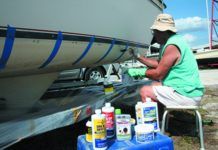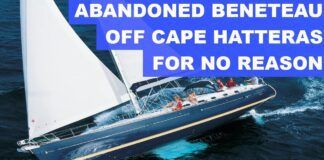Spirit of Joel White
I enjoyed very much your discussion of super-capable sailing electronics, and unnecessary equipment, and how they have taken over the simplicity and traditions of the sailing experience. (“Choose Your Own Seductions,” April 1) No doubt all but a very few of us have come to rely on GPS for providing security and confirmation in tricky navigational situations. It is a shame, however, to see how many people have come to use this wonderful tool to the exclusion of practicing traditional navigation skills. If you are not working on the water, boats for most of us are a means to escape the pressures of life on land, at our offices and homes. Especially for the sailor, time aboard is a chance to step back in time and enjoy the simple and gratifying pleasures of sailing, navigating, and living on the water with nothing but the wind on the sails for motive force. The more items from the modern world we bring with us into this refuge the less of an escape it becomes. It is one thing to become frustrated by a fluky breeze, a tangled line, or a tricky navigational problem on the chart-that is all part of the sailing experience and the solutions are usually quite gratifying. It becomes quite another kind of frustration, one very much like what we experience all the time in our high-stress work-a-day lives, when a problem aboard is caused by overly complicated or incompatible software, a balky mechanical device such as electric winch or windlass, or arguing with the kids over how much TV they can watch and video game time they can have below. These are the types of devices and aggravations I go to sea to get away from, so the less things aboard that can provide this stress the better I like it.
I just finished work on a book about Joel White, his sailing, boatbuilding and designing. Joel was a great advocate of simplicity aboard the boats he sailed and designed. I thought the following excerpt from the book was relevant to your provocative discussion on complications unnecessarily brought aboard. This is written by Bill Mayher as he remembers cruising with Joel:
“Just as Joel wasn’t a boat shopper, he wasn’t a gear guy either. While others appear to own boats as much for the expanded arena of consumption they provide as for the actual sailing, Joel got no thrill from gizmos.
“…This simplicity represents one skirmish in Joel’s lifelong war to make the world less complicated. As a builder and designer, even though it would be profitable for him and the yard to tack on extras, he regularly found himself in the position of trying to talk his clients out of stuffing extraneous apparatus into their boats. He just couldn’t seem to help himself. When he heard about some new piece of equipment, his first thought was, ‘When’s this thingamabob going to break down, anyway?’
“The case of Loran pretty well summed up his thinking on this matter. Early in our cruising days when Loran was just becoming affordable for small boats, we would often meet up with a befuddled yachtsman marooned in some foggy outport by a malfeasance in his new Loran receiver – vacation days sliding recklessly by, his wife mumbling below in the grip of near-miss- induced catatonia. What this skipper needed was either improved visibility or the arrival of technical help and, most likely, neither of these things was about to happen any time soon. For Joel, such moments seemed like Old Testament retribution. What we have here, he would later suggest, was a man lured beyond the range of his navigational capacities on the slender thread of some sort of electronic fiddle-faddle. No such thing would happen to us. We would stick to the tried-and-true: our dividers, our parallel rules, our taffrail log, and our compass. Furthermore, we would keep our navigational skills honed by welcoming the challenges of fog at every opportunity.
“In this state of mind, we sailed eastward summer after summer into fog so thick you could spread it on an English muffin. Fog defined our cruising. Day after day we stared into an impenetrable gray wall with nose a-drip and ears ringing from a lack of bell buoys, monitoring depth contours minute-to-minute on the old paper recorder, and recalculating current flow estimates with each passing pot buoy. But after such days when at last we battened down in some snug anchorage, it must also be said that we shared levels of contentment and satisfaction unknown to today’s mariners guided by the wizardry of the latest electronic devices.
“Of course to make navigation work the old-fashioned way, Joel had to be a patient fundamentalist never discombobulated by either carelessness or a crumbling faith in his own reckonings. In the fog we never aimed for an area rife with prickly hazards. Instead we sought bell buoys or bold shores to shoot for, even if these took us out of our way.”
-Benjamin Mendlowitz
Brooklin, ME
The book, Joel White: Boatbuilder, Designer, Sailor, with Mr. Mendlowitz’s photography, is gorgeous. It’s published by Noah Publications and distributed by W.W. Norton.
———-
Congratulations for telling it like it is. Your editorials are a remarkable breath of fresh air amongst the avalanche of hype thrown at sailors by the marine industry. It is about time we began to sort out the fundamental need and value of the myriad of new products that claim to do everything better.
Too often it has been my experience that new so-called purpose-designed products are no better and frequently inferior to long-tried methods. For example, for more years than I wish to admit, hard rigging, stainless, and teak have been preserved against the ravages of the sea with nothing more than ordinary, cheap, and easily applied anhydrous lanolin paste.
The same goes for much new equipment that serves the sailor no better than traditional methods and more often than not places undue reliance upon the odds of failure that seriously undermine high-tech hardware.
-Robert W. Haddock
Strasbourg, France
———-
Gloves and Exposure
I found your article on cold-weather gloves valuable (April 15). I am in general agreement with your recommedations. However, I suggest your readers consider a layered approach. My recommendation after roughly 300 hours of winter boating, fishing, and duck hunting on Lakes Ontario and Erie is the following:
1. Ragg Wool 1/2-Finger Gloves from Cabela’s.Catalog number LB-92-0108.$12.These allow the fingertips to be exposed to perform intricate tasks.Even if they are wet, they provide some warmth. I find them adequate in moderate temperatures, say down to 40 degrees F.
2.I add Elkskin Chopper Mitts with ragg wool mitten liners from Cabela’s over the 1/2-Finger Gloves in colder conditions. Catalog number LB-92-0156. $23. I have been out for up to four hours in temperatures of 0 degrees F with winds over 20 knots with these gloves on with no problems. I slip the mitts and liners off when I tie a fishing line or fire a shotgun. I keep the 1/2-Finger Gloves on.
I use the same glove combination when I hunt on land in the winter. If I had to deal with a lot of green water and had to have a pair of waterproof gloves, I would consider the Sealskinz Waterproof Gloves from Cabela’s because they are available in the extra long guantlet style. Catalog number LB-92-1398.$35.
I have fallen several times into very cold water.No fun, and potentially life threatening. To reduce my risk of death by hypothermia, I bought a Mustang Anti-Exposure Coverall model MS2175. When boating and fishing in cold weather or when the water temperature is below 68 degrees F, I now generally wear my Mustang Coverall.I love it! It is warm, comfortable, windproof, waterproof, and is a USCG Class V PFD. It is not breathable, but I just zip down the front chest zipper if I get too warm.
Thanks for your article on cold-weather gloves.You do a great job.
-Mark L. Corson
Pepper Pike, OH
Shortly after we published the cold-weather glove feature, we learned that Grandoe is no longer making the Winner gloves we recommended. Jeff Lee of Grandoe tells us that the current Horizon glove would be the best replacement. Features are DriGard waterproof/breathable insert, Diamond Tek Leather palm with leather fingers, ThermaDry insulation, Stretch Microfleece wristlet, and adjustable wrist strap. They retail for $34.99.
As for exposure suits, without having tried any of the competition, we can attest to the quality and effectiveness of the Mustang PFD coveralls. We used them for years on a fire/rescue boat, and one winter considered giving up the house and just living in the suit. Cozy and warm, good padding, plenty of deep pockets…
———-
Our club, the Mamaroneck Frostbite Association, has spent a good deal of time trying to find the appropriate gloves for those cold winter days when we race our 9-foot Dyer Dhows. Mainsheets occassionally trail in the water and get wet, and there is a need for a degree of dexterity. The gloves we use must be warm, waterproof, and permit us the ability to adjust sheet, and outhaul and to belay a halyard and to “feel” the tiller.
I was hoping that your recent article on cold-weather gloves might offer us a new product to consider, but after careful study, it seems that the gloves we have found are superior to anything that you reviewed. Much of our fleet is using commercial fisherman’s gloves, the kind that lobstermen and offshore fishermen use out there in the cold weather.
They are thick vinyl gloves with acrylic pile lining, yet they provide enough dexterity, as you called it, to accomplish the tasks. They are warm to about 20 degrees – if it gets colder, I wear thin nylon liners inside and that takes me down another 10 degrees. The brand name on the gloves is ATLAS Vinyl Glove No. 460. They are made in Malaysia and I am sure that they are available on any commercial waterfront.
I hope you will pass this information on to your readership, of which I count myself a devoted member.
-William H. Donat
Mamaroneck Frostbite Association
We used to wear similar vinyl fisherman’s gloves while PHRF racing in cold weather. They were called “The Claw.” The Stanley HandiHelpers in our review are not as tough (molded) but are probably more agile. Thanks for the tip on the Atlas gloves. They’re available from Seattle Marine & Fishing Supply, 800/426-2783, www.seamar.com.
———-
Mailport Requests
Practical Sailor gets a constant, heavy flow of mail. Our abject apologies to those who send letters that don’t get answered. We read them all-you’re not sending them into a void. But if we tried to answer everything, there would be no magazine.
If possible, send letters as straight e-mail. Attached files won’t be downloaded unless contact is made with the author. E-mail with embedded files won’t be opened at all.
If you don’t have access to e-mail, paper will still work. It’s just, like, so way old-timey.





































